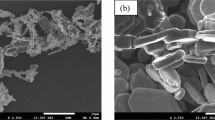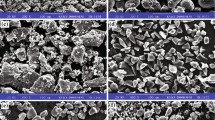Abstract
Advanced ceramics find significant application areas due to their superior mechanical, electrical, magnetic chemical and thermal properties. By combining these materials, significant properties can be obtained as a result of production of the composites of hard metal compounds in nanoscale dimensions. Self-propagated high-temperature synthesis (SHS) is one of the prominent methods for the production of such nanoparticles. SHS is a combustion synthesis method. In this study, nanocomposite powders of B4C-TiB2 were synthesized by SHS method. FactSage software was used for thermochemical simulation and computational stoichiometric optimization. In the experimental step, 2 different SHS sets were prepared. In the first stage, B4C and TiB2 powders were synthesized. The B4C-TiB2 composite was produced in the final set of experiments. Then, production parameters of B4C-TiB2 composite powders, from B2O3, TiO2, and carbon black, were investigated. Magnesium powder was used as reductant agent. Afterwards, HCl leaching process was performed, and acid concentration was optimized. The effect of carbonic acid and H2O2 addition on dissolution of undesired phases was also been investigated as a new method. Products were characterized by XRD, SEM and BET analysis. B4C-TiB2 composite powder with quite high surface area, fine particle size and high porosity could be synthesized with reasonable purity. According to the results, the optimum molar ratios were determined as TiO2:B2O3:Mg:C = 1:3:12:1.6. Optimum acid concentration was found to be 10.5 M for leaching process, and carbonic acid addition on leaching step found to be effective on TiO2 removal. The highest purity could be obtained with 50%-50% stoichiometry. It has also been determined that the synthesis of B4C-TiB2 composite powder has a positive effect on both the chemical content and the morphology that will increase the sintering ability.











Similar content being viewed by others

References
Cinar Sahin, F.: Lecture Note: Production of Hard Metal Compounds. Univ, Istanbul Tech (2007)
Dariel, M.P., Frage, N.: Reaction bonded boron carbide: recent developments. Adv. Appl. Ceram. (2012). https://doi.org/10.1179/1743676111Y.0000000078
Xin, L., Minjun, L., Shuaibo, G., Shu, Y., Xiaofeng, W., Pengfei, X.: Effect of initial compositions on boron carbide synthesis and corresponding growth mechanism. Adv. Appl. Ceram. (2019). https://doi.org/10.1080/17436753.2019.1664792
Crouch, I.G., Eu, B.: The Science of Armour Materials - Ballistic testing methodologies, pp. 639–673, Woodhead Publishing in Materials (2017). https://doi.org/10.1016/B978-0-08-100704-4.00011-6
Domnich, V., Reynaud, S., Haber, R., Chhowalla, M.: Boron carbide: structure, properties and stability under stress. J. Am. Ceram. Soc. (2011). https://doi.org/10.1111/j.1551-2916.2011.04865.x
Savio, S. G., Sambasiva Rao, A., Rama Subba Reddy, P., Madhu, V.: Microstructure and ballistic performance of hot pressed & reaction bonded boron carbides against an armour piercing projectile. Advances in Applied Ceramics (2019). https://doi.org/10.1080/17436753.2018.1564416
Chen, S., Wang, D., Huang, J., Ren, Z.F.: Synthesis and characterization of boron carbide nanoparticles. Appl. Phys. A. (2004). https://doi.org/10.1007/s00339-004-2913-6
Wood, C.: Materials for thermoelectric energy conversion. Rep. Prog. Phys. (1988). https://doi.org/10.1088/0034-4885/51/4/001
Suri, A.K., Subramanian, C., Sonber, J.K., Murthy, T.S.RCh.: Synthesis and consolidation of boron carbide: a review. Int. Mater. Rev. (2010). https://doi.org/10.1179/095066009X12506721665211
Sauerschnig, P., Watts, J.L., Vaney, J.B., Talbot, P.C., Alarco, J.A., Mackinnon, I.D.R., Mori, T.: Thermoelectric properties of phase pure boron carbide prepared by a solution-based method. Adv. Appl. Ceram. (2020). https://doi.org/10.1080/17436753.2019.1705017
Madhav Reddy, K., Guo, J., Shinoda, Y., et al.: Enhanced mechanical properties of nanocrystalline boron carbide by nanoporosity and interface phases. Nat. Commun. (2012). https://doi.org/10.1038/ncomms2047
Heydari, M.S., Baharvandi, H.R.: Comparing the effects of different sintering methods for ceramics on the physical and mechanical properties of B4C–TiB2 nanocomposites. Int. Journal of Refractory Metals and Hard Materials (2015). https://doi.org/10.1016/j.ijrmhm.2015.04.003.
Tallon, C., Franks, G.V.: Exploring inexpensive processing routes to prepare dense TiB2 components. Adv. Appl. Ceram. (2016). https://doi.org/10.1080/17436753.2016.1172166
Mukhopadhyay, A., Raju, G.B., Basu, B., Suri, A.K.: Correlation between phase evolution, mechanical properties and instrumented indentation response of TiB2-based ceramics. J. Eur. Ceram. Soc. (2009). https://doi.org/10.1016/j.jeurceramsoc.2008.06.030
Riccer,i R., Matteazzi, P.: A fast and low-cost room temperature process for TiB2 formation by mechanosynthesis. Mater. Sci. Eng. (2004). https://doi.org/10.1016/j.msea.2004.02.064
Górnya, G., Rączkaa, M., Stobierskia, L., Rożniatowskib, K., Rutkowskia, P.: Ceramic composite Ti3SiC2–TiB2-microstructure and mechanical properties. Mater. Charact. (2009). https://doi.org/10.1016/j.matchar.2009.03.011
Bilgi, E., Camurlu, H.E., Akgun, B., Topkaya, Y., Sevinc, N.: Formation of TiB2 by volume combustion and mechanochemical process. Mater. Res. Bull. (2008). https://doi.org/10.1016/j.materresbull.2007.05.001
Subramanian, C., Murthy, T.S.RCh., Suri, A.K.: Synthesis and consolidation of titanium diboride. Int. J. Refract. Met. Hard. Mater. (2007). https://doi.org/10.1016/j.ijrmhm.2006.09.003
Kang, S.H., Kim, D.J.: Synthesis of nano-titanium diboride powders by carbothermal reduction. J. Eur. Ceram. Soc. (2007). https://doi.org/10.1016/j.jeurceramsoc.2006.04.053
Li, X., Wang, S., Nie, D., Liu, K., Yan, S., Xing, P.: Effect and corresponding mechanism of NaCl additive on boron carbide powder synthesis via carbothermal reduction. Diam. Relat. Mater. (2019). https://doi.org/10.1016/j.diamond.2019.107458
Kakiage, M., Kobayashi, T.: Fabrication of boron carbide fibers consisting of connected particles by carbothermal reduction via electrospinning. Mater. Lett. (2019). https://doi.org/10.1016/j.matlet.2019.07.028
Tang, W.-M., Zheng, Z.-X., Wu, Y.-C., Wang, J.-M., Lu, J., Liu, J.-W.: Synthesis of TiB2 nanocrystalline powder by mechanical alloying. Trans. Nonferrous. Met. Soc. China. (2006). https://doi.org/10.1016/S1003-6326(06)60108-8
Hwang, Y., Lee, J.K.: Preparation of TiB2 powders by mechanical alloying. Mater. Lett. (2002). https://doi.org/10.1016/S0167-577X(01)00526-2
Schmidt, J., Boehling, M., Burkhardt, U., Grin, Y.: Preparation of titanium diboride TiB2 by spark plasma sintering at slow heating rate. Sci. Technol. Adv. Mater. (2007). https://doi.org/10.1016/j.stam.2007.06.009
Chakraborti, A., Vast, N., Le Godec, Y.: Synthesis of boron carbide from its elements at high pressures and high temperatures. Solid. State. Sci. (2020). https://doi.org/10.1016/j.solidstatesciences.2020.106265
Baca, L., Stelzer, N.: Adapting of sol–gel process for preparation of TiB2 powder from low cost precursors. J. Eur. Ceram. Soc. (2008). https://doi.org/10.1016/j.jeurceramsoc.2007.09.028
Suna Avcioglu, Figen Kaya, Cengiz Kaya, Non-catalytic synthesis of boron carbide (B4C) nano structures with various morphologies by sol-gel process, Materials Letters, Volume 249, 2019, Pages 201–205, ISSN 0167–577X, https://doi.org/10.1016/j.matlet.2019.04.056.
Abolhassan, N., Golestani-Fard, F., Rezaie, H.R.: Sol-gel synthesis and characterization of B4C nanopowder. Ceram. Int. (2018). https://doi.org/10.1016/j.ceramint.2018.08.196
Kim, J.W., Shim, J., Ahn, J., Cho, Y.W., Kim, J., Oh, K.H.: Mechanochemical synthesis and characterization of TiB2 and VB2 nanopowders. Mater. Lett. (2008). https://doi.org/10.1016/j.matlet.2007.12.022
Deng, F., Xie, H.Y., Wang, L.: Synthesis of submicron B4C by mechanochemical method. Mater. Lett. (2006). https://doi.org/10.1016/j.matlet.2005.12.016
Gadakary, S., Khanra, A.K., Veerabau, R.: Production of nanocrystalline TiB2 powder through self-propagating high temperature synthesis (SHS) of TiO2–H3BO3–Mg mixture. Adv. Appl. Ceram. (2014). https://doi.org/10.1179/1743676114Y.0000000188
İpekçi, M., Acar, S., Elmadağlı, M., Hennicked, J., Balcı, Ö., Somer, M.: Production of TiB2 by SHS and HCl leaching at different temperatures: characterization and investigation of sintering behavior by SPS. Ceram. Int. (2017). https://doi.org/10.1016/j.ceramint.2016.10.174
Khanra, A.K., Godkhindi, M.M.: Comparative studies on sintering behavior of selfpropagating high-temperature synthesized ultra-fine titanium diboride powder. J. Am. Ceram. Soc. (2005). https://doi.org/10.1111/j.1551-2916.2005.00236.x
Aghili, S., Panjepour, M., Meratian, M., Hadadzadeh, H.: Effects of boron oxide composition, structure, and morphology on B4C formation via the SHS process in the B2O3 Mg – C ternary system. Ceram. Int. (2020). https://doi.org/10.1016/j.ceramint.2019.11.217
Yaghoubi, M., Torabi, O.: Effect of the magnesium content on the mechanochemical behavior in ternary system Mg–B2O3–C. Int. J. Refract. Metals. Hard. Mater. (2014). https://doi.org/10.1016/j.ijrmhm.2013.11.014
Munir, Z.A., Anselmi-Tamburini, U.: Self-propagating exothermic reactions: the synthesis of high-temperature materials by combustion. Mater. Sci. Rep. (1989). https://doi.org/10.1016/0920-2307(89)90001-7
Xue, H., Munir, Z.A.: Extending the compositional limit of combustion synthesized B4C–TiB2 composites by field activation. Metall. Mater. Trans. B. 27, 475–480 (1996)
Fard, H.S.P., Baharvandi, H.R., Abdizadeh, H., Shahbahrami, B.: Chemical synthesis of nano-titanium diboride powders by borothermic reduction. Int. J. Mod. Phys. B. (2008). https://doi.org/10.1142/S0217979208048085
Pei, L.Z., Xiao, H.N.: B4C–TiB2 composite powders prepared by carbothermal reduction method. J. Mater. Process. Technol. (2009). https://doi.org/10.1016/j.jmatprotec.2008.05.003
Çakir, E., Ergun, C., Şahin, F.Ç., Erden, I.: In situ synthesis of B4C/TiB2 composites from low cost sugar based precursor. Defect. Diffus. Forum (2010). https://doi.org/10.4028/www.scientific.net/DDF.297-301.52
Hongqiang, R., Haifei, X., Liang, Y., Peng, L., Xiaodong, L., Guanming, Q.: Microstructure of TiB2/B4C composites with 1% Y2O3 prepared by co-precipitating and in situ synthesis. J. Rare. Earths (2007). https://doi.org/10.1016/S1002-0721(07)60520-1
Biedunkiewicz, A., Figiel, P., Gabriel, U., Sabara, M., Lenart, S.: Synthesis and characteristics of nanocrystalline materials in Ti, B, C and N containing system. Cent. Eur. J. Phys. (2011). https://doi.org/10.2478/s11534-010-0121-x
Mikeladze, A., Tsagareishvili, O., Chkhartishvili, L., Chedia, R., Darchiashvili, M.: Production of titanium-containing metal-ceramic composites based on boron carbide in the nanocrystalline state. Adv. Appl. Ceram. (2019). https://doi.org/10.1080/17436753.2019.1611088
Chkhartishvili, L., Mikeladze, A., Chedia, R., Tsagareishvili, O., Barbakadze, N., Sarajishvili, K., Darchiashvili, M., Ugrekhelidze, V., Korkia, T.: Synthesizing fine-grained powders of complex compositions B4C–TiB2–WC–Co. Solid. State. Sci. (2020). https://doi.org/10.1016/j.solidstatesciences.2020.106439
Tolendiuly, S., Fomenko, S., Abdulkarimova, R., Mansurov, Z., Dannangoda, G., Martirosyan, K.: The effect of MWCNT addition on superconducting properties of MgB2 fabricated by high-pressure combustion synthesis. Int. J. Self. Propag. High. Temp. Synth. (2016). https://doi.org/10.3103/S1061386216020138
Nikzad, L., Licheri, R., Vaezi, M.R., Orrù, R., Cao, G.: Chemically and mechanically activated combustion synthesis of B4C–TiB2 composites. Int. J. Refract. Metal. Hard. Mater. (2012). https://doi.org/10.1016/j.ijrmhm.2012.04.001
Ziemnicka-Sylwester, M.: TiB2-based composites for ultra-high-temperature devices, fabricated by SHS, combining strong and weak exothermic reactions. Materials. (2013). https://doi.org/10.3390/ma6051903
Panek, Z.: The synthesis of SiC-B4C ceramics by combustion during hot-pressing. J. Eur. Ceram. Soc. (1993). https://doi.org/10.1016/0955-2219(93)90092-6
Shojaie Bahaabad, M.: Mechanically activated combustion synthesis of B4C-TiB2 nanocomposite powder. J. Adv. Mater. 5, 13–21 (2017)
Merzhanov, A.G., Borovinskaya, I.P.: Self-spreading high-temperature synthesis of refractory compounds. Dokl. Chem. 204(2), 429–431 (1972)
Su, X.L., Fu, F., Yan, Y.G., Zheng, G., Liang, T., Zhang, Q., Cheng, X., Yang, D.W., Chi, H., Tang, X.F., Zhang, Q.J., Uher, C.: Self-propagating high-temperature synthesis for compound thermoelectrics and new criterion for combustion processing. Nat. Commun. (2014). https://doi.org/10.1038/ncomms5908
Tan, X., Xianli, Su., Yan, Y., Uher, C., Zhang, Q., Tang, X.: New criteria for the applicability of combustion synthesis: the investigation of thermodynamic and kinetic processes for binary Chemical Reactions. J. Alloy. Compd. (2021). https://doi.org/10.1016/j.jallcom.2020.158465
Alkan, M., Sonmez, M.S., Derin, B., Yucel, O.: Effect of initial composition on boron carbide production by SHS process followed by acid leaching. Solid. State. Sci. (2012). https://doi.org/10.1016/j.solidstatesciences.2012.07.004
Turan, A., Bugdayci, M., Yucel, O.: Self-propagating high temperature synthesis of TiB2. High. Temp. Mater. Proc. (2015). https://doi.org/10.1515/htmp-2014-0021
Alkan, M., Sonmez, M.S., Derin, B., Yucel, O., Andreev, D., Sanin, V., Yukhvid, V.: Production of Al-Co-Ni ternary alloys by the SHS method for use in nickel based superalloys manufacturing. High. Temp. Mater. Processes. (London) (2015). https://doi.org/10.1515/htmp-2014-0052
Yucel, O., Bugdayci, M., Turan, A.: Recent ferroalloy studies at Istanbul Technical University. KnE Materials Science (2019). https://doi.org/10.18502/kms.v5i1.3956
Moghaddam, S., Derin, B., Yucel, O., Sonmez, M., Sezen, M., Bakan, F., Sanin, V., Andreev, D.: Production of Mo2NiB2 based hard alloys by self-propagating high-temperature synthesis. High. Temp. Mater. Processes. (London) (2019). https://doi.org/10.1515/htmp-2019-0020
Bugdayci, M., Turan, A., Benzesik, K., Yucel, O.: Production of nano B4C–ZrB2 composite powders via self-propagating high-temperature synthesis (Shs) and effects of functional additives on the SHS of monolithic ZrB2. Nano. Studies. 13, 191–204 (2016)
Yasushi, H., Masahiro, A., Hiroaki, H.: Composition for dissolving titanium oxide and dissolution method using it (2007). Patent Number: US 2007/O125986 A1.
Gu, Y., Qian, Y., Chen, L., Zhou, F.: A mild solvothermal route to nanocrystalline titanium diboride. J. Alloy. Compd. (2003). https://doi.org/10.1016/S0925-8388(02)01173-8
Huang, F.L., Bao Cao, C., Xiang, X., Lv, R.T., Zhu, H.S.: Synthesis of hexagonal boron carbonitride phase by solvothermal method. Diam. Relat. Mater. (2004). https://doi.org/10.1016/j.diamond.2004.03.001
Acknowledgements
The authors would like to thank Dr. Amir Motallebzadeh from Koç University Surface Science and Technology Center (KUYTAM) for BET Surface Area Analysis.
Author information
Authors and Affiliations
Corresponding author
Ethics declarations
Conflict of interest
The authors declare no competing interests.
Additional information
Publisher’s note
Springer Nature remains neutral with regard to jurisdictional claims in published maps and institutional affiliations.
Rights and permissions
About this article
Cite this article
Coban, O., Bugdayci, M. & Acma, M.E. Production of B4C-TiB2 composite powder by self-propagating high-temperature synthesis. J Aust Ceram Soc 58, 777–791 (2022). https://doi.org/10.1007/s41779-022-00714-5
Received:
Revised:
Accepted:
Published:
Issue Date:
DOI: https://doi.org/10.1007/s41779-022-00714-5



